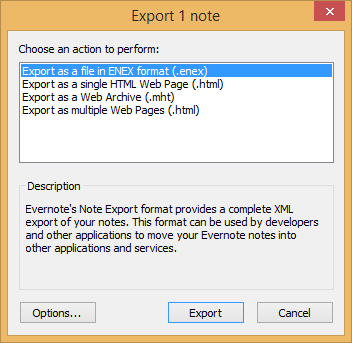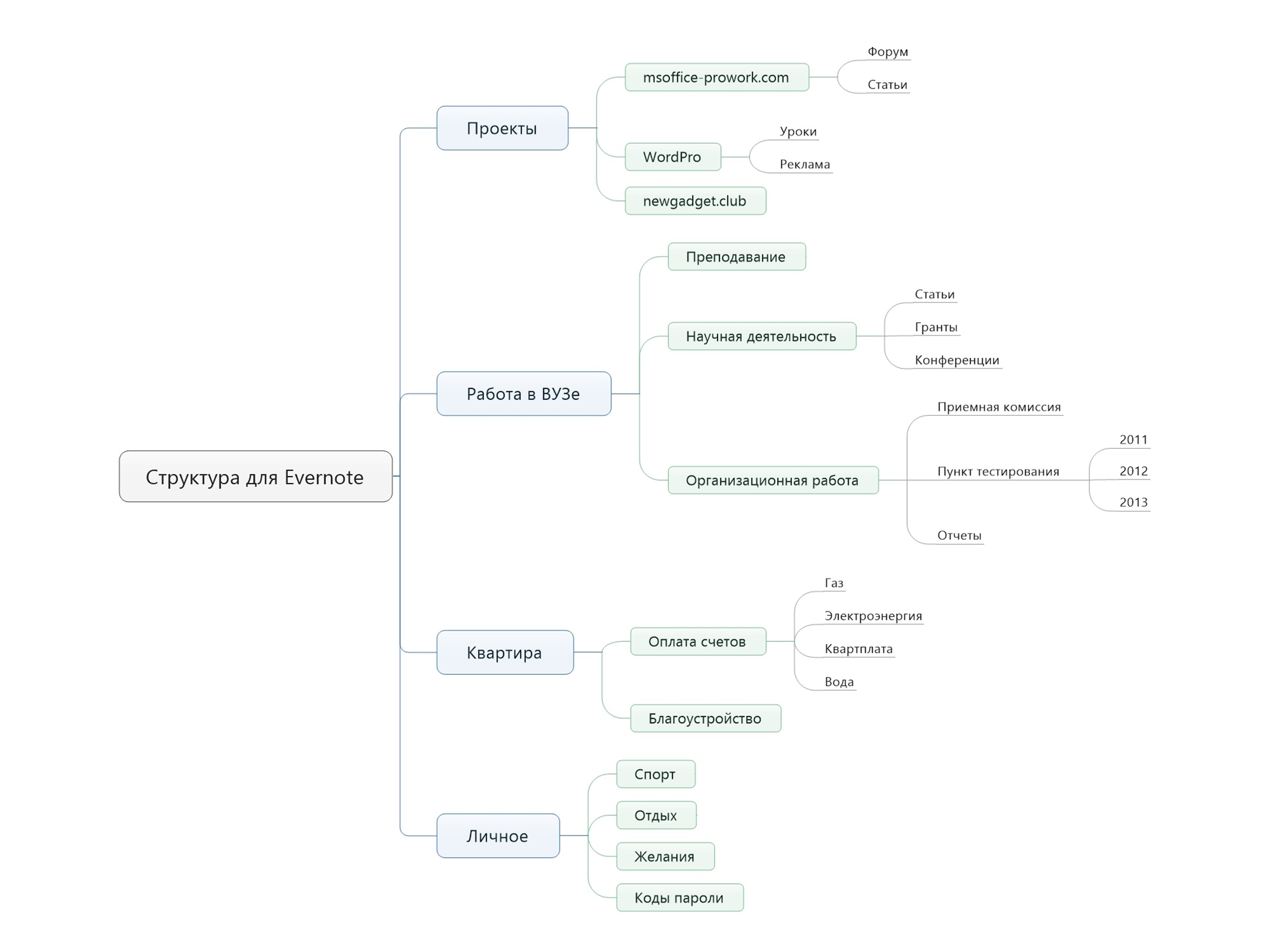How to use Evernote correctly
This material will be written in the first person, since, by and large, it reflects the author’s personal experience when working with the Evernote notebook program.
Evernote is a task management software, but often its incorrect use can not improve the user's productivity, but add confusion to the already information-rich life of a modern person.
What is Evernote?
The next subsection is dedicated to those who do not know what this program is and how it can be used. Evernote is an excellent tool for self-organization not only of the business life, but also of the personal life of a modern person. Let me give you a few examples.
You are preparing an essay, a report, a diploma: the work itself is written in a word processor, interesting bookmarks for materials from the Internet are saved in browser bookmarks, useful material found in a paper book (yes, yes, there are still paper books), photographed on the phone, and then moved to a special folder with the project, and there are also ideas that arise at the most inopportune moment, for example, during a walk in the park, and if you don’t write them down, you can simply forget them. In addition, the idea can be represented by a photograph, audio or video note.
Another example. You are involved in an accident, you need to photograph the scene of the accident, record the data of the other driver, possibly witnesses, clarify the procedure for further action with the inspectors - all this is information that will need to be saved.
Next example. We have many passwords to various programs, services, many different keys to licensed products - they all need to be stored, and preferably in such a way that the place itself is protected.
You can give many examples with preparation, a seminar, choosing a new car, looking for a job, vacation, etc. this list goes on and on, probably the purpose of this program is best described by the slogan of the developers “Remember everything”.
Now a few words about how Evernote can be useful if we are away from the computer. The fact is that Evernote is not just a program for PC, it is a program for PC, mobile platforms, and an Internet service. That is why a note can be made in almost any conditions (I don’t consider situations where you are in the middle of the desert, far from people, without a computer, the Internet or a smartphone).
I think it would be useful to note once again that the free version of the program is very functional, moreover, I myself use the free version of the program.
Why this material at all?
It’s clear, a good product, in principle, it’s quite easy to understand, why do we need this material at all?
For a long time I used Evernote by analogy with an ordinary notebook, i.e. created a record, while the current problem situation is being solved, the record is used, but if you switch to another task, the previous records disappear into oblivion. If you solve all the problems sequentially, there is nothing wrong with this, however, such situations, as a rule, do not happen. We solve many problems at the same time: renovations in an apartment, a project at work or several tasks that need to be kept under control, life situations, for example, an accident (God forbid, of course), etc. and in this case, this approach to using Evernote is extremely unproductive; some good ideas may simply be forgotten. In addition, a false impression is created that the program does not help, but simply forces you to do unnecessary actions.
Using Evernote as a simple notebook is extremely unproductive and creates the false impression that the program does not help, but simply forces you to do unnecessary actions.
Why is this happening?
The fact is that when we start using the program without training, but in the “old fashioned” way, using the “scientific poke” method, we begin to use the most familiar way of organizing data, when many notebooks and many tags are created. At the same time, it is simply impossible to create a full-fledged structure using notebooks, because Only one level of nesting is allowed, and the user simply does not think about tags and uses them, just like, for example, when describing an article on a website, or adding keywords to a Word document.
It turns out that notebooks are being created that can duplicate the functional focus, and the increase in the number of tags turns them into a useless cataloging tool. You have to waste time twice: the first time when you create a note and think where it belongs, what tags to assign to it and whether similar tags have already been used, and the second time when you want to find what you wrote down. As a result, a feeling of fictitious usefulness of the program is created.
There is a feeling of fictitious usefulness of the program
This is approximately what the records of a typical user look like, who has not fully understood the correct structuring of data (compare with your organization option in Evernote).
I'll add a small comment. The information seems to be collected, but does not bring practical use in the long term; for many records tags were not assigned at all, and some tags contained only 1-2 records and these are the majority. The only exception was the Sticky notes tag, since it included all the entries from the built-in Stiky notes application, at the same time, a lot of notebooks had accumulated, as a result, searching for information was complicated.
How to organize information correctly?
Organizing information in Evernote can most easily be compared with cataloging data in the system itself; for example, I worked as a teacher at a university for a long time, and accordingly, a lot of information on subjects has accumulated. A typical path to access information for a specific subject looks something like this: “My documents\ Work at the university\ Subjects for teaching\ Name of the subject\ Folders of the subject itself”

The nesting may be greater, but it is already clear that at least 4 levels are used. In fact, you need to do something similar in Evernote, but the maximum nesting of notebooks is limited to the second level, you will have to use a different approach, since it is provided by the developers.
The essence of the “different” approach is to carry out the structuring itself not with the help of notebooks, but with the help of tags, in contrast to the keywords that are familiar to all of us, which are used in articles, scientific projects, in documents; in Evernote, from keywords you can create a structure, at the same time, the level of nesting is not limited, and if it is limited, then it is at a very high level, although I did not set out to find the limit of nesting, for the sake of interest, I created 10 levels of nesting, and decided not to check further, because It's unlikely to be useful in real life.
Backup copy.
Redesigning the record structure is unlikely to jeopardize the integrity of the records, but if there are concerns, you can make a backup copy of the data. This is done very simply, command: “File\Export...” and select the first format in the list - this is Evernote’s own format.

Implementation of the remodeling plan.
The change will take place in several steps.
Firstly, we remove all old tags and form the future post structure. The structure will continue to change in the future, so the main thing is to outline the general outlines.
When creating a structure for keywords, it is necessary to take into account that tags, although they are in the structure, are actually separate elements, what does this mean. Firstly, there cannot be two identical tags, despite the fact that they are in different categories, and secondly, if you select a top-level keyword, it will not include entries from lower-level tags, for example, according to my structure, tag selection “Pay bills” does not mean that all records that relate to “Gas”, “Electricity”, “Water” will be selected. On the other hand, several keywords can be assigned to one entry, both in a chain of the same structure and in different ones, for example, all codes and passwords are stored in the “Personal” tag structure, however, some of the passwords are assigned a tag from the “Projects” structure "
If you want, when selecting, for example, the “Projects” tag, all lower-level tags are selected, you can assign all tags in the “Projects” chain to the record; however, for myself, I chose a different approach, which will be discussed further.

The caption of the drawing is “My original structure, later you will see that, in the end, it took on a completely different look.”
Secondly, We scatter existing records according to the formed structure, simultaneously deleting unnecessary records, I have accumulated enough of them.
Third, but what to do with notebooks, since the entire structure is now represented by tags? There are different recommendations on the Internet, some recommend creating one notebook, so to speak, a database of all records, there are tips on creating two notebooks - one for
As for adding notebooks, you can create one, which will be a database, but it is better to use several, for example, you can create one to provide public access to existing records, and another for personal use.
I have developed an approach for myself so that the number of books corresponds to the number of top-level tags. On the one hand, when creating the next entry, you need to make sure that it ends up in the right book, but over time, this is done automatically, but, on the other hand, this organization allows you to select all entries by a specific top-level tag without assigning tags from the entire tag chain.
You can create another book if you need to provide shared access to records; I did not have such a need.
And this is what the post structure looks like after a complete rework:
The desired record can be found quickly thanks to convenient cataloging.







